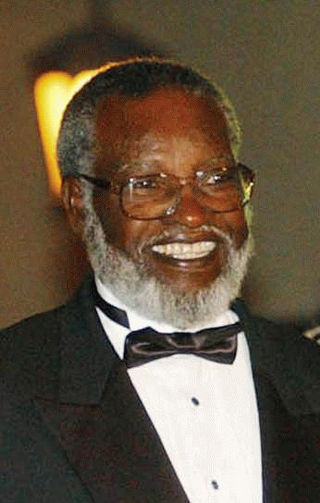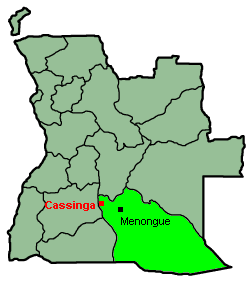Related Research Articles
The history of Namibia has passed through several distinct stages from being colonised in the late nineteenth century to Namibia's independence on 21 March 1990.

The South West Africa People's Organisation, officially known as the SWAPO Party of Namibia, is a political party and former independence movement in Namibia. Founded in 1960, it has been the governing party in Namibia since the country achieved independence in 1990. The party continues to be dominated in number and influence by the Ovambo ethnic group.

Samuel Shafiishuna Daniel Nujoma, is a Namibian revolutionary, anti-apartheid activist and politician who served three terms as the first President of Namibia, from 1990 to 2005. Nujoma was a founding member and the first president of the South West Africa People's Organization (SWAPO) in 1960. Prior to 1960, SWAPO was known as the Ovambo People's Organisation (OPO). He played an important role as leader of the national liberation movement in campaigning for Namibia's political independence from South African rule. He established the People's Liberation Army of Namibia (PLAN) in 1962 and launched a guerrilla war against the apartheid government of South Africa in August 1966 at Omungulugwombashe, beginning after the United Nations withdrew the mandate for South Africa to govern the territory. Nujoma led SWAPO during the lengthy Namibian War of Independence, which lasted from 1966 to 1989.
Operation Reindeer, which began on 4 May 1978, was South Africa's second major military operation in Angola, carried out under the Apartheid regime, the first being Operation Savannah.
The Battle of Cassinga also known as the Cassinga Raid or Kassinga Massacre was a controversial South African airborne attack on a South West Africa People's Organization (SWAPO) military camp at the town of Cassinga, Angola on 4 May 1978. Conducted as one of the three major actions of Operation Reindeer during the South African Border War, it was the South African Army's first major air assault operation.
The following lists events that happened during 1978 in South Africa.

The South African Border War, also known as the Namibian War of Independence, and sometimes denoted in South Africa as the Angolan Bush War, was a largely asymmetric conflict that occurred in Namibia, Zambia, and Angola from 26 August 1966 to 21 March 1990. It was fought between the South African Defence Force (SADF) and the People's Liberation Army of Namibia (PLAN), an armed wing of the South West African People's Organisation (SWAPO). The South African Border War resulted in some of the largest battles on the African continent since World War II and was closely intertwined with the Angolan Civil War.
Ella Ndatega Kamanya was a Namibian politician and businesswoman. She joined the South West Africa People's Organization (SWAPO) in exile in 1978 and survived the Battle of Cassinga by the South African Army.

Cassinga or Kassinga is a town and commune in the municipality of Jamba, province of Huíla, Angola.

The Caprivi conflict was an armed conflict between the Namibian government and the Caprivi Liberation Army, a rebel group that waged a brief insurrection in 1999 for the secession of the Caprivi Strip.

The People's Liberation Army of Namibia (PLAN) was the military wing of the South West Africa People's Organisation (SWAPO). It fought against the South African Defence Force (SADF) and South West African Territorial Force (SWATF) during the South African Border War. Throughout its history, PLAN had both irregular insurgent and semi-conventional units, as well as an extensive recruitment network in rural South West Africa (Namibia). During the war most of its domestic activities consisted of mine warfare and acts of sabotage. PLAN initially lacked any standing units, and the bulk of operations were carried out by political exiles who spent cyclical periods residing in refugee camps in neighbouring states before launching raids inside South West Africa itself. By the end of the war, PLAN had 32,000 militants under arms, including three battalions of semi-conventional troops equipped with heavy weapons.
Heroes' Day is a national public holiday in Namibia. It is recognized by the United Nations as Namibia Day. Celebrated annually on 26 August, the day commemorates the Namibian War of Independence which began on 26 August 1966 at Omugulugwombashe.
Lieutenant General Mweukefina Kulaumone Jerobeam Dimo Hamaambo was a Namibian military commander in both the Namibian War of Independence as a SWAPO member and in independent Namibia as the Chief of Defence in the Namibia Defence Force. He became the second commander of the People's Liberation Army of Namibia (PLAN) in 1967 after the death of Tobias Hainyeko and held the position until independence was gained in 1990.
Doreen Nampiye Sioka is a Namibian politician. She is member of the National Assembly of Namibia since 1994 for the South West Africa People's Organization (SWAPO), and a member of the cabinet since 2005, serving as Minister of Gender Equality, Poverty Eradication and Social Welfare.
Omugulugwombashe is a settlement in the Tsandi electoral constituency in the Omusati Region of northern Namibia. The settlement features a clinic and a primary school. In 1966, the first battle of the South African Border War was fought in Omugulugwombashe. The government of Namibia erected a monument on the 30th anniversary of the battle in 1996.

44 Parachute Brigade was a parachute infantry brigade of the South African Army. It was founded on 20 April 1978, by Colonel Jan Breytenbach, following the disbandment of 1 SA Corps and the battle of Cassinga. Upon formation, the brigade was commanded by Brigadier M. J. du Plessis, who was assigned the task of establishing by working with the Parachute Staff Officer, Colonel Jan Breytenbach. At the time du Plessis was the commanding officer of the Orange Free State Command and had previous experience serving in 1 Parachute Battalion. Breytenbach had also been a member of 1 Parachute Battalion and had also founded the South African Special Forces Brigade and 32 Battalion. The location that was chosen for the brigade's headquarters was in the lines of the OFS Cmd Headquarters, next to the old Tempe Airfield in Bloemfontein.
Monica Nashandi is a Namibian diplomat and politician. Nashandi was Namibia's ambassador to Scandinavian countries as well as the former High Commissioner to the United Kingdom. Nashandi was removed from the SWAPO list for the 2009 general election because she had not registered to vote, a requirement under Namibian law. Nashandi was Namibia's ambassador to the United States of America from 2019 to 2020.
John ya Otto Nankudhu was a Namibian guerrilla, army officer and politician. He was the commander of the forces of the People's Liberation Army of Namibia (PLAN) at Omugulugwombashe when the armed struggle for independence began there on 26 August 1966 and was later jailed for 17 years at Robben Island. He is a National Hero of Namibia for his contributions to the independence of the country.

The Bagaka Regiment is a reserve airborne infantry regiment of the South African Army.
Simeon Linekela Kambo Shixungileni, was a Namibian guerrilla, army officer and politician. He was the second commander in -charge of the forces of the People's Liberation Army of Namibia (PLAN) at Omugulugwombashe when the armed struggle for independence began there on 26 August 1966 and was later jailed at Robben Island. He is a National Hero of Namibia for his contributions to the independence of the country.
References
- ↑ Let's Review Our National Holidays in The Namibian, 27 April, 2007
- ↑ The Commonwealth Yearbook Archived September 27, 2007, at the Wayback Machine
- ↑ Namibian national reconciliation policy in Xinhua News Agency, 21 September, 2006.
- ↑ Muraranganda, Elvis (3 May 2016). "Remembering Cassinga Day". New Era . p. 3.